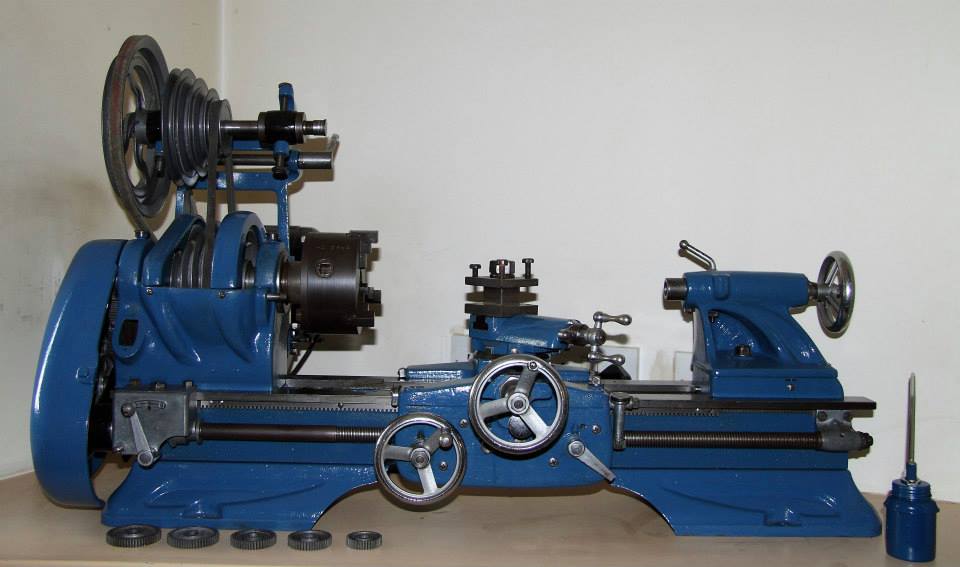Atlas 10F
This is a restoration project we undertook of an Atlas 10F lathe
The Background
A few years ago, a friend of mine, who knew I had an interest in engineering tools and who had seen an example of an earlier restoration job I had done on an old engineering vise, asked me if I would be interested in an old Lathe that he owned. He didn't know much about it other than he had bought it some 30 years ago "from a chap for £20", and used it a bit when he was in his 20's, but since then it had been rusting away in his Fathers shed down in Devon (Apparently his father used it occasionally but not for the last 10 years or so). My friend no longer had a use for it, but from sentimental value would love to see it restored. A few weeks later he turned up with this.







Initial Research
As with all restoration projects, the first thing to do is research. After a little digging on the web we established this was an American made lathe dating back to the 1940 -1950's. The more we dug into the history, the more exciting the project became. Might this lathe be connected somehow with the monumental war effort of Britain during World War II.
The History Bit
Prior to the signing of the Lend Lease Act by President Roosevelt in March of 1941, Britain had been buying war materiel from the United States on a Cash and Carry basis. Whilst much of the focus of these purchases were on ships, vehicles and armaments, Britain also required large quantities of machine tools to equip it's massively expanding armaments industry.
As any good machinist knows, one of the mainstays of an engineering workshop is a Lathe, especially when you are having to produce huge quantities of gun barrels, threaded screws and the 101 other steel, aluminium and brass widgets and thingamajigs that go into building war machines and their weapons. At the time, one of the best and (and due to American Mass production techniques, cheapest) multi-speed, multi-geared, powered cross feed lathes on the market was the Atlas 10F made by the Atlas Press Company of Kalamzoo, Michigan, USA.
The Strip Down
So began the long, occasionally frustrating, very very dirty but great fun job of stripping down the machine to it's component parts. Each one of the over 1000 components from the huge one piece Lathe bed to the tiniest grub screw was removed and cleaned. All the old paint from a badly done restore 30+ years ago had to be stripped off and the pieces wire wool sanded clean by hand. Some minor repair work was needed on several components but the majority of the work was done with good old fashioned sweat and elbow grease.
The All Important Dating Evidence
So the all important day comes when we disassemble the headstock for the first time. After some serious muscle work (almost all from Metalerman), we finally managed to get the main spindle and bearings out and I was able to wipe off 40 years of grease to get a date.
Sorry for the bad photo but 2-29-40 or 29th February 1940 in old money.
The dates on the other 3 components were all between End February and Late July 1940 giving us a factory assembly date of approx August - September 1940.
As I am sure you can imagine, this was a big "Hell yeah!" moment as we finally had the proof that we were indeed working on a WWII era lathe.
The Restoration
After taking the mill apart, each piece was painstakingly cleaned, oiled, painted and re-assembled. We were able to find a pdf of the original manual online which helped a bit but mostly we had to take notes at each stage to know how to put the damn thing back together. I hope you will agree that the final results were worth every minute.
Recall to Duty
Once restored of course this could have become nothing more than a museum piece, an example of a great piece of 1940's engineering. In fact for a whole three years the lathe sat pride of place in my living room as a showpiece. But at Iron Wolf Engineering we can't let good tools sit idle and after a major rethink of our working environment the lathe was moved back to where it belongs, in a functioning workshop. New tooling was bought, youtube videos were watched, 35 year old high school skills were dusted off and the Atlas 10F lived again. One day it may need to be replaced with a 21st century version and be retired for a third time, but until then it is part of what we do.
The Reality
Now, a careful reader will of course see that I lack any kind of provenance for this story. It would be almost impossible to prove that this Lathe was indeed shipped to the UK during the 1940's, used in the armaments industry, or has any connection whatsoever to the production of RAF warplanes or other war related material used during WWII. That said, I like to think that due to it's date, the fact it is in the UK to begin with and the fact that so much of the countries engineering industry between 1940-45 was employed in the War effort that it is not too big a leap to say that our restoration was "very likely" to have been used for something connected to the war effort.
And sometimes, especially when I power it up, I like to imagine a dedicated machinist at Vickers-Armstrongs working late into the night turning out the barrels for the .303 Spitfire machine guns.










